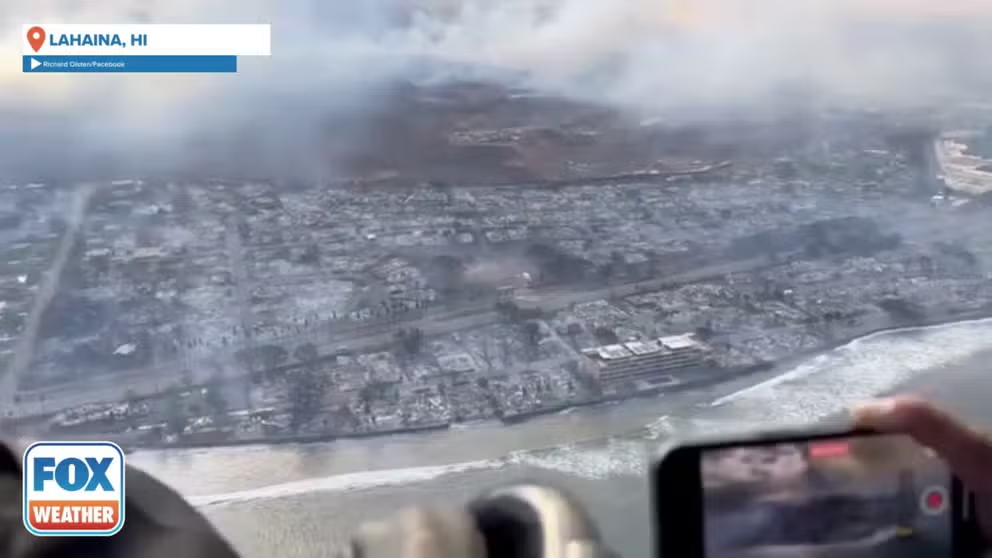When can Maui start rebuilding? How toxic debris from deadly fires is slowing recovery
Officials tasked with identifying and removing dangerous and toxic debris from California’s Camp Fire that destroyed the town of Paradise explain the process of cleaning up hazards after the fire and how long it takes to even start to rebuild.
Slow progress searching through Hawaii debris after wildfire
FOX News' William LaJeunesse brings us the latest on the death toll and the number of residents still missing after deadly wildfires scorched Maui.
While fire crews are still dousing hotspots and officials sift through ashes of burned homes for human remains, Hawaiians are already asking, "When can we rebuild?" California wildfire officials warn of a long road ahead.
More than 2,000 homes, businesses and structures were incinerated by the Maui fire in Lahaina alone. Burned hulks of cars still line Front Street where drivers, stuck in evacuation traffic, had to run and swim for safety. Flames scorched 2,700 acres on the Hawaiian island.
Aerial video shows complete devastation across parts of Maui after catastrophic brush fires
Richard Olsten, owner and operator of Air Maui Helicopter Tours, took video of the island after sunrise, which showed smoldering homes and businesses.
Burn area dangerous to humans
"Yes, it is toxic. Anytime you burn a home, you're looking at polyphenols and other hydrocarbons that are released from plastics and other things that burn within the house that are much different than a standard forest fire," said Josh Jimerfield, Butte County, California Deputy Administrative Officer for the Office of Emergency Management.
"In any urban environment, all those things that are not supposed to burn, plastics and refrigerants, all those things that are in the appliances that we use every day, laminate type materials, any of that is going to leave some residual," he continued.
Jimerfield, a debris subject-matter expert, worked with the Army Corp of Engineers during the Camp Fire cleanup. The California fire was the deadliest in the U.S. in the past 100 years until the Maui fires. The 2018 firestorm killed at least 85 people, destroyed more than 18,000 structures and blackened more than 153,000 acres.
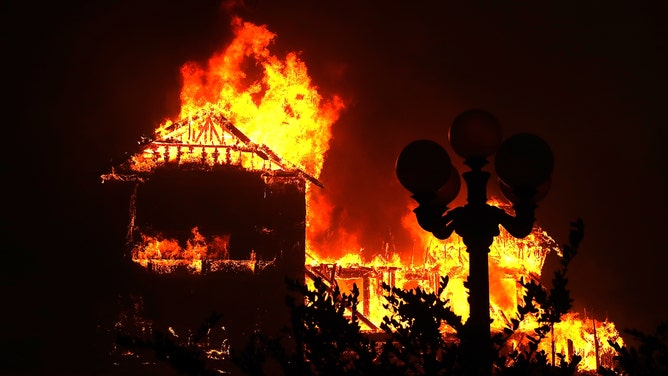
File: A home burns as the Camp Fire moves through the area on November 8, 2018 in Paradise, California.
(Justin Sullivan / Getty Images)
He said there is a process after a major wildfire. Hawaii already declared a Public Health Emergency as step one. In California, that allows the Environmental Protection Agency and the Department of Toxic Substances to do a rapid assessment and search for household hazardous waste.
"That can be anything, like what they consider orphan containers. So propane tanks from a barbecue that could be partially damaged," Jimerfield said. "Any other things, from the shed like paints, or gasolines, or other chemicals that are normal to a home."
Asbestos is also highly hazardous after it has burned. The substance was very popular for building materials in the 1960s and 1970s.

File: An aerial view of homes destroyed by the Camp Fire on February 11, 2019 in Paradise, California. Three months after the deadly and destructive Camp Fire, the community is beginning the rebuilding process.
(Justin Sullivan / Getty Images)
"Any asbestos, once it's burned, becomes what they call friable. So it's very dangerous to breathe," Jimerfield said. "(Crews) go into private property initially and look for and mark and remove the material that they can now process (which) can take anywhere from a couple of weeks to months depending on the scope of the damage for the fire."
He said that step took a couple of months for the Camp Fire.
After the EPA clears the property, officials may allow residents back in to search for belongings that did not burn like jewelry, he continued. Anyone sifting through ash should wear gloves and masks for safety and make sure not to spread the burnt remains out.
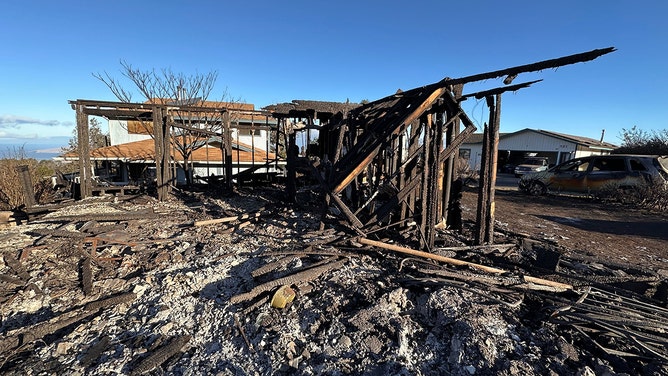
Of the three fires that burned, officials say the Kula Fire in Upcountry Maui destroyed over 500 structures and charred nearly 700 acres. Officials projected Kula’s rebuilding costs at $434 million.
(Robert Ray / FOX Weather)
Contaminated water and soil
"And then ultimately, there's a bigger concern, too, for any of the fires," he said. "Because all those contaminants, when you get rain and stormwater runoff, that all is going to leach ultimately into the river systems, the lakes and streams around us."
The soil is also contaminated.
"Burned structural debris from homes can contaminate the underlying soil and should be removed prior to rebuilding," said Chris McSwain, spokesperson for CalRecycle, which specializes in wildfire debris and its removal. "Contaminants include but are not limited to lead, mercury, arsenic, and chromium. Common sources include household chemicals, electronics, appliances, batteries, furniture, and vehicles.
Jimerfield said crews had to remove 3 to 6 inches of soil from most burned areas in Paradise. How much soil depends on how hot the fire burned and scarred the soil, though.
"Studies have been done after the Napa/Sonoma fires and the Camp Fire," Jimerfield added. "And we've had toxicologists from the federal side to come in and look and determine how deep these lesions of the soils do we need to take out, two inches of topsoil underneath the fire footprint, or does it need to be three feet of soil?"
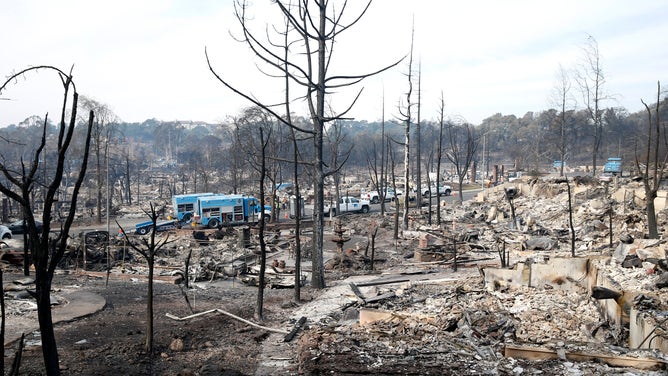
File: The Fountain Grove neighborhood in Santa Rosa, California was just one of many burned by the Tubbs fire across Napa and Sonoma.
(Paul Chinn/The San Francisco Chronicle / Getty Images)
When can Maui rebuild?
He said that CalRecycle has been a leader in testing and determining what can be cleaned and reused versus ending up in a landfill. Concrete, one example, loses its strength after being superheated, but it is not necessarily contaminated. In some cases, scientists are able to break down the concrete and use it in roadbeds.
"What does all that look like to ensure that when a property is officially clean and handed back to a homeowner, is it safe for them to build? Is it safe for kids to be out playing in that dirt for pets and animals to be out in that environment?" he continued.
Water safety is also a main concern. Expected rain from the remnants of Tropical Storm Greg can spread the pollutants.
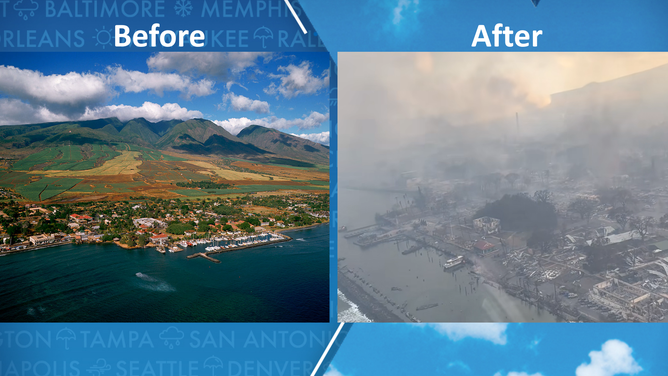
Aerial View of Lahaina on the Coast of Maui
(Douglas Peebles/Corbis via Getty Images/Richard Olsten/Facebook / FOX Weather)
"Higher burn severity wildfires and higher numbers of man-made infrastructure and vehicles that are destroyed in the fire are more likely to create harmful conditions for water quality, especially in areas with higher precipitation rates, saturated soils, and overland flows that transport chemicals from burned debris to receiving waters," said Blair Robertson, Public Information Officer of the California Water Resources Control Board.
Heavy rains and runoff can carry the pollutants into larger waterways and reservoirs. Scientists will be keeping an eye on aquatic homes too. Increasing nutrient levels can lead to harmful algae blooms like red tide. The runoff can change the pH, temperature and dissolved oxygen levels, too, which is harmful to wildlife.
Residents of Kula, in the mountains in the center of Maui, have been able to return to their neighborhoods. Officials still have Lahaina’s burned area sealed off to homeowners and the public.

